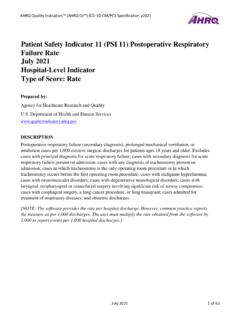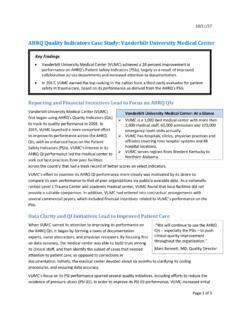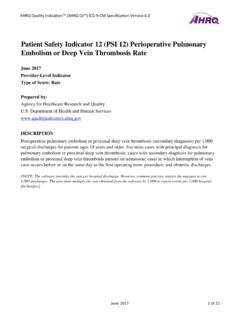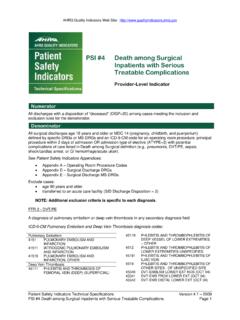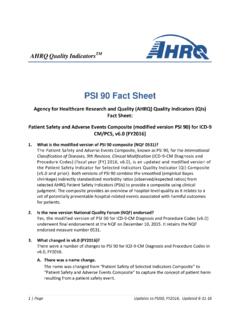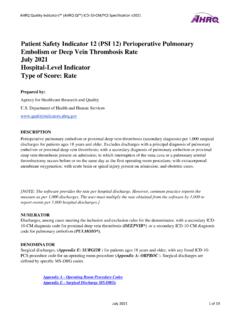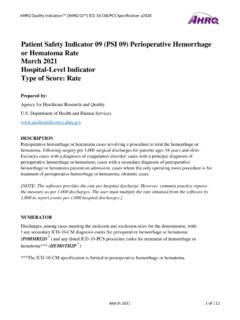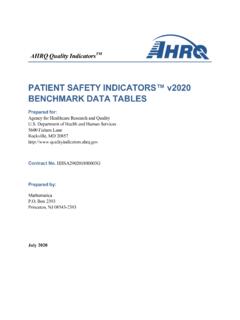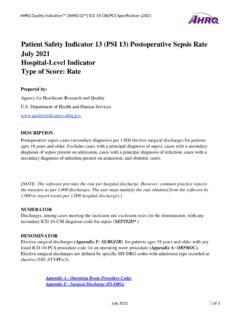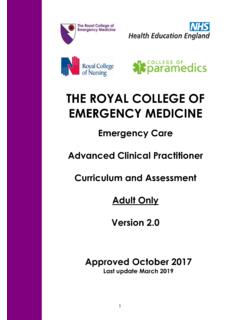Transcription of Patient Safety Indicators (PSI) Benchmark Data Tables, v2021
1 AHRQ Quality IndicatorsTM Patient Safety Indicators (PSI) Benchmark Data Tables, v2021 Prepared for: Agency for Healthcare Research and Quality Department of Health and Human Services 5600 Fishers Lane Rockville, MD 20857 Contract No. HHSA290201800003G July 2021 AHRQ Quality IndicatorsTM Patient Safety Indicators (PSI) Benchmark Data Tables, v2021 Version 2021 Page i July 2021 Table of Contents 1 Acknowledgments .. 2 PSI Benchmark Tables .. 3 Index of Tables Table 1. Patient Safety Indicators (PSI) for Overall Population: Hospital-Level Indicators .. 3 Table 2. PSI 02 Death Rate in Low-Mortality Diagnosis Related Groups (DRGs) .. 5 Table 3. PSI 03 Pressure Ulcer Rate .. 5 Table 4. PSI 04 Death Rate among Surgical Inpatients with Serious Treatable Complications .. 6 Table 5. PSI 04 Death Rate among Surgical Inpatients with Serious Treatable Complications Stratum: Deep Vein Thrombosis/Pulmonary Embolism (DVT/PE).
2 6 Table 6. PSI 04 Death Rate among Surgical Inpatients with Serious Treatable Complications Stratum: Pneumonia .. 7 Table 7. PSI 04 Death Rate among Surgical Inpatients with Serious Treatable Complications Stratum: Sepsis .. 7 Table 8. PSI 04 Death Rate among Surgical Inpatients with Serious Treatable Complications Stratum Shock/Cardiac Arrest .. 8 Table 9. PSI 04 Death Rate among Surgical Inpatients with Serious Treatable Complications Stratum Gastrointestinal (GI) Hemorrhage/Acute Ulcer .. 8 Table 10. PSI 05 Retained Surgical Item or Unretrieved Device Fragment Count .. 9 Table 11. PSI 06 Iatrogenic Pneumothorax Rate .. 9 Table 12. PSI 07 Central Venous Catheter-Related Blood Stream Infection 10 Table 13. PSI 08 In Hospital Fall with Hip Fracture 10 Table 14. PSI 09 Perioperative Hemorrhage or Hematoma Rate .. 11 Table 15. PSI 10 Postoperative Acute Kidney Injury Requiring Dialysis Rate.
3 11 Table 16. PSI 11 Postoperative Respiratory Failure Rate .. 12 Table 17. PSI 12 Perioperative Pulmonary Embolism or Deep Vein Thrombosis (PE/DVT) Rate .. 12 Table 18. PSI 13 Postoperative Sepsis Rate .. 13 Table 19. PSI 14 Postoperative Wound Dehiscence Rate .. 13 Table 20. PSI 14 Postoperative Wound Dehiscence Rate Stratum: Open .. 14 Table 21. PSI 14 Postoperative Wound Dehiscence Rate Stratum: Non-Open .. 14 Table 22. PSI 15 Abdominopelvic Accidental Puncture or Laceration Rate .. 15 AHRQ Quality IndicatorsTM Patient Safety Indicators (PSI) Benchmark Data Tables, v2021 Version 2021 Page ii July 2021 Table 23. PSI 17 Birth trauma Rate Injury to Neonate .. 15 Table 24. PSI 18 Obstetric trauma Rate Vaginal Delivery with Instrument .. 16 Table 25. PSI 19 Obstetric trauma Rate Vaginal Delivery without Instrument .. 16 AHRQ Quality IndicatorsTM Patient Safety Indicators (PSI) Benchmark Data Tables, v2021 Version 2021 Page 1 July 2021 Introduction The data presented in this document are nationwide comparative rates for Version 2021 of the Agency for Healthcare Research and Quality (AHRQ) Quality IndicatorsTM (QI) Patient Safety Indicators (PSI) software.
4 The numerators, denominators, and observed rates shown in this document are based on an analysis of discharge data from the 2018 AHRQ Healthcare Cost and Utilization Project (HCUP) State Inpatient Databases (SID). HCUP is a family of healthcare databases and related software tools and products developed through a Federal-State-Industry partnership. HCUP includes the largest collection of longitudinal hospital care data in the United States, with all-payer, encounter-level information beginning in 1988. The SID contains all-payer, encounter-level information on inpatient discharges, including clinical and resource information typically found on a billing record, such as Patient demographics, up to 30 International Classification of Diseases, Tenth Revision, Clinical Modification/Procedural Classification System (ICD-10-CM/PCS) diagnoses and procedures, length of stay, expected payer, admission and discharge dates, and discharge disposition.
5 In 2018, the HCUP databases represented more than 97 percent of all annual discharges in the United States. The analytic dataset used to generate the tables in this document consists of the same hospital discharge records that comprise the reference population for Version 2021 of the AHRQ QI software. This reference population file was limited to community hospitals and also excludes rehabilitation and long-term acute care (LTAC) hospitals. Information on the type of hospital was obtained by the American Hospital Association (AHA) Annual Survey of Hospitals. AHA defines community hospitals as all non-Federal, short-term, general, and other specialty hospitals, excluding hospital units of institutions. Included among community hospitals are specialty hospitals such as obstetrics-gynecology, ear-nose-throat, orthopedic, and pediatric institutions. Also included are public hospitals and academic medical centers.
6 In 2018, 46 of the SID include Indicators of the diagnoses being present on admission (POA) and 42 included the procedure day (PRDAY) data element. Discharges from these 46 participating States are used to develop hospital-level Edit checks on POA were developed during an HCUP evaluation of POA coding in the 2011 SID at hospitals that were required to report POA to the Centers for Medicare & Medicaid Services (CMS, ). The edits identify general patterns of suspect reporting of POA. The edits do not evaluate whether a valid POA value ( , Y or N) is appropriate for the specific diagnosis. There are three hospital-level edit checks: 1. Indication that a hospital has POA reported as Y on all diagnoses on all discharges 2. Indication that a hospital has POA reported as missing on all non-Medicare discharges 3. Indication that a hospital reported POA as missing on all nonexempt diagnoses for 15 percent or more of discharges.
7 The cut-point of 15 percent was determined by 2 times the standard 1 States in the 2018 reference population for the hospital-level Indicators include: AK, AR, AZ, CACO, DC, DE, FL, GA, HI, IA, IL, IN, KS, KY, LA, MA, MD, ME, MI, MN, MO, MS, MT, NC, ND, NE, NJ, NM, NV, NY, OH, OK, OR, PA, RI, SC, SD, TN, TX, UT, VA, VT, WA, WI, and WV. Note that Colorado, Hawaii and New York were not used in the development of PSI 17. Wisconsin, Oklahoma, West Virginia, and Delaware were not used to develop PSI 04, PSI 09, PSI 10, PSI 11, PSI 12, PSI 14, AND PSI 15. AHRQ Quality IndicatorsTM Patient Safety Indicators (PSI) Benchmark Data Tables, v2021 Version 2021 Page 2 July 2021 deviation plus the mean of the percentage for hospitals that are required to report POA to CMS. Additional information on the reference population and the risk adjustment process may be found in Quality Indicator Empirical Methods, available on the AHRQ QI website ( ).
8 The QI observed rates for hospital-level Indicators are scaled to the rate per 1,000 persons at risk (discharges). Count indicator results are listed as simple counts with no scaling at all. Cell sizes less than 11 are suppressed due to confidentiality; and are designated by an asterisk (*). When only one data point in a series must be suppressed due to cell sizes, another data point is provided as a range to disallow calculation of the masked variable. Acknowledgments The AHRQ QI program would like to acknowledge the HCUP Partner organizations that participated in the HCUP SID: Alaska State Hospital and Nursing Home Association, Alaska Department of Health and Social Services, Arizona Department of Health Services, Arkansas Department of Health, California Office of Statewide Health Planning and Development, Colorado Hospital Association, Connecticut Hospital Association, Delaware Division of Public Health, District of Columbia Hospital Association, Florida Agency for Health Care Administration, Georgia Hospital Association, Hawaii Laulima Data Alliance, a non-profit subsidiary of the Healthcare Association of Hawaii, Hawaii University of Hawaii at Hilo, Illinois Department of Public Health, Indiana Hospital Association, Iowa Hospital Association, Kansas Hospital Association, Kentucky Cabinet for Health and Family Services, Louisiana Department of Health, Maine Health Data Organization, Maryland Health Services Cost Review Commission.
9 Massachusetts Center for Health Information and Analysis, Michigan Health & Hospital Association, Minnesota Hospital Association (provides data for Minnesota and North Dakota), Mississippi State Department of Health, Missouri Hospital Industry Data Institute, Montana Hospital Association, Nebraska Hospital Association, Nevada Department of Health and Human Services, New Hampshire Department of Health & Human Services, New Jersey Department of Health, New Mexico Department of Health, New York State Department of Health, North Carolina Department of Health and Human Services, North Dakota (data provided by the Minnesota Hospital Association), Ohio Hospital Association, Oklahoma State Department of Health, Oregon Association of Hospitals and Health Systems, Oregon Office of Health Analytics, Pennsylvania Health Care Cost Containment Council, Rhode Island Department of Health, South Carolina Revenue and Fiscal Affairs Office, South Dakota Association of Healthcare Organizations, Tennessee Hospital Association, Texas Department of State Health Services, Utah Department of Health, Vermont Association of Hospitals and Health Systems, Virginia Health Information, Washington State Department of Health, West Virginia Department of Health and Human Resources , Wisconsin Department of Health Services, Wyoming Hospital Association.
10 AHRQ Quality IndicatorsTM Patient Safety Indicators (PSI) Benchmark Data Tables, v2021 Version 2021 Page 3 July 2021 PSI Benchmark Tables Table 1. Patient Safety Indicators (PSI) for Overall Population: Hospital-Level Indicators INDICATOR LABEL NUMERATOR DENOMINATOR OBSERVED RATE PER 1,000 DISCHARGES PSI 02 Death Rate in Low-Mortality Diagnosis Related Groups (DRGs) 1,058 2,105,316 PSI 03 Pressure Ulcer Rate 9,887 15,995,803 PSI 04 Death Rate Among Surgical Inpatients with Serious Treatable Complications 34,940 244,204 PSI 04 Stratum_DVT_PE Death Rate Among Surgical Inpatients with Serious Treatable Complications Stratum: Deep Vein Thrombosis/Pulmonary Embolism (DVT/PE) 1,217 29,287 PSI 04 Stratum_PNEUMONIA Death Rate Among Surgical Inpatients with Serious Treatable Complications Stratum: Pneumonia 9,368 104,069 PSI 04 Stratum_SEPSIS Death Rate Among Surgical Inpatients with Serious Treatable Complications Stratum.
